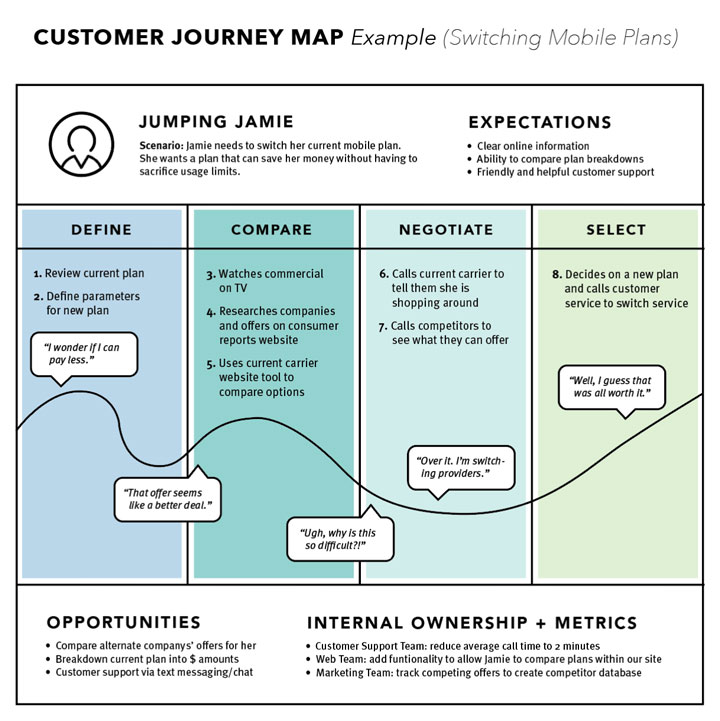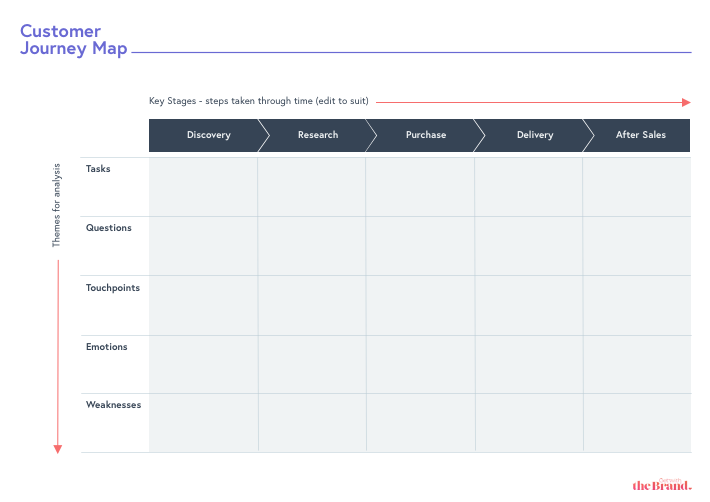Customer Journey Mapping is a tool used to define, then visualise the path a user takes as they engage with your organisation, product or service. Think of it like a persona on the move.
In this article, we will explore the real value of creating Customer Journey Maps and discover when and why it would be beneficial to utilize them within your organisation.
Definition: A journey map is a visualization of the process that a person goes through in order to accomplish a goal.
~ NN Group
But what are Customer Journey Maps?
Customer Journey Maps are one of the many tools a UX professional can call upon to demonstrate how to improve your users experience in relation to your product or service.
They will provide you with a visual representation of your users journey, either from the initial point of contact to the end-goal, or for a section of that experience along the way. You may choose to create a map of the current journey (to find problems), or the aspirational journey (to show how life could/should be).
By creating a visual time-line, then adding the users goals and actions as they begin to engage, we can start to build up a picture of the path our clients/customers take to get to where they need to be. As we consider what they might think, and how they might feel as they move through this process, we can add their emotions and thoughts into the mix. This in turn, enables us to gain insights as to where we might be falling short, so we can address these pain-points and micro-moments in order to create a delightful experience and a happier user.
Ultimately, this will lead to a more positive perception of your organisation, whilst increasing the return on any marketing spend.
Why would we create a Customer Journey Map?
Once considered a nice-to-have, Customer Journey Maps are increasingly becoming an essential part of the planning and decision making process for any customer-centered organisation.
Research conducted by the Aberdeen Group reported that companies who mapped and managed the customer journey successfully, saw on average, a 24.9% increase in revenue from associated marketing campaigns and a 21.2% reduction in service costs (compared to previous year).
A Customer Journey Mapping exercise will enable you/your team to take a virtual walk in the shoes of your customers. How does your organisation look from their point of view? What are they going though at any given part of the process? What is the experience like for them on a personal level? What delights them and what are their pain-points? Where are the opportunities to improve?
Once created, your Customer Journey Map can be developed into a visual communication of your users experience, enabling you and your people to make decisions with your user front-of-mind. This is a win-win, bringing a joint sense of purpose and clarity internally, whilst making life better/easier for your customers externally.
What are the benefits of a Customer Journey Mapping session?
A Customer Journey Mapping session will help you to:
- put the needs of your customers first, so that your organisation can respond to them in the best way possible.
- define any pain-points and gaps in your customers overall experience, so that they can be addressed and problems can be solved.
- enable departments and whole organisations to visualize and understand the bigger picture and where they fit into it.
- give the people in your organisation a shared sense of clarity regarding needs of your customers.
- help your designer make informed design decisions, so that they can help your customers get where they want to go quickly and easily.
- help your marketing and communications team create copy that responds to the right questions at the right time, in the right tone.
- make it easier for your internal teams to find a way to prioritise future work.
You’ve got to start with the customer experience and work back toward the technology, not the other way around
~ Steve Jobs
When is a Customer Journey Map a good idea?
There are a few different scenarios where you might benefit from Customer Journey Mapping. They include (but are not limited to):
When you are ready to redesign or make incremental improvements to your website or overall marketing strategy.
When we consider a redesign of our website, it’s almost always because the site is ‘dated’ or has become bloated and difficult to navigate. The common approach is to take the existing content, reshuffle it and make it more visually appealing. The new website is launched and we congratulate ourselves on a job well done. At no point in this process, do we stop to get the opinion of people we are actually building the website for. Instead we rely on ‘best practice’ and a bunch of assumptions we have made about our customers.
This is guesswork and can be a dangerous approach, leaving the likelihood of a positive return on your investment to chance. The new site looks great, but may not answer the questions your user came to ask. By trying to better understand your users and their journey in relation to your product or service, the higher the likelihood that we will collaboratively create an online/digital experience that will meet and hopefully exceed their expectations.
When you have a known business goal.
That goal might be to inform decisions about a new website (above), or discover whether a new feature might be helpful. It could also be an external problem, such as working out where support gaps are, or where your customer service/customer communication is lacking.
When you need to bring a team together.
As organisations grow beyond a certain size, departmental silos almost always creep into existence. By conducting a Customer Journey Mapping Workshop with stakeholders and staff, you can expect to develop a shared sense of ownership leading to greater collaboration between departments.
A Customer Journey Mapping Workshop can also be used to define who is responsible for what within your organisation. It will highlight any areas where customer support is lacking, enabling these blind-spots to be uncovered and allocated to the right team.
When you need to find the cause of an existing problem.
Whilst we can quite easily get our hands on lots of data about our users, working out why they behave in a certain way is a challenge of its own. Customer Journey Mapping can help your team to understand and account for trends in qualitative data.
Selling to the same customer more than once is almost always cheaper than finding a new customer. If customer retention is a problem for your organisation, a Customer Journey Mapping workshop could help you work out why.
When you are serving more than one market.
Your organisation will likely have more than one user persona, especially true if you’re targeting more than one market or demographic. For example you may have customers in B2B and B2C, or local and international students etc. Whilst the thing you’re selling may be essentially the same, the questions, concerns and barriers to entry will be very different for your different user groups. Customer Journey Maps will help you to personalise your marketing and processes to better support each audience.
So, we’ve covered the what, what and when. Now for the how.
How do you create a Customer Journey Map?
Customer Journey Maps are the output of a Journey Mapping Workshop. There are various ways of conducting the workshop, but the end-goal is generally the same – to gain valuable insights as how you can improve the experience you provide to your customers.

Steps to conducting a successful Customer Journey Mapping Workshop
1. Get the right people in the room.
Getting stakeholders involved is essential to your project’s success. One of the many benefits of Journey Mapping is that it can help to unify stakeholders and internal departments at the start of a project.
Making sure that key decision makers (usually senior management), anyone who has direct contact with customers (customer service / sales / marketing) and anyone involved in the delivery of the project (digital teams, communications staff) are on-board from the beginning will offer a distinct advantage.
If you can get an actual customer or two in the room better still. They won’t necessarily need to be involved for all of the workshop, but will most definitely be able to provide valuable insights.
In short, you want both the people that are instrumental in delivering the customer experience, and those who are removed from it but are key influencers in the decision making process.
2. Set the stage.
Once you have the right people in the right place at the right time (not easy but worth the effort!), you can let participants know what to expect. Basic housekeeping always helps people settle in, so let people know when the tea/lunch break is and how long the session/s will run for.
3. Know your goal, decide on a persona.
By this stage you will have already decided whether to create the current journey, aspirational (future) journey, or both, so explain this to your participants. You’ll also need to decide which part of the journey you are hoping to capture as part of this exercise.
It’s not usual for an organisation to be targeting more than one market, so you’ll need to decide which audience/persona you’re going to be basing your journey map on.
We are trying to discover what your customer needs at any given moment in their journey, so it will help if you’re focussed on a specific character. You can create other maps for other persona’s, but it’s best to focus on one at a time.
Review what you already know about your customer’s experience, you can collate past research or direct customer feedback. By working out what you know, you can more easily see what you don’t know, and then try to fill in any blanks.

4. Create your map.
There are many different variations on the Customer Journey Map. Here is a template that you can download for free. Print it out (as large as you can) and stick it on a wall so everyone can see.
Define the Key Stages:
The Customer Journey Map Template above has 5 key stages: Discovery, Research, Purchase, Delivery and After Sales. These will vary depending on what you offer and which part of the journey you are hoping to map, so decide on these before you begin.
Work out what you’re trying to work out:
What are you doing the workshop for? What is it that you are trying to find out? What do you want to know about your user? What do you want to know about the key stages of their journey in relation to your product or service?
An example might be: ‘Collect information to make decisions about the redesign of a NFP website’, or ‘Improve the application process for new students’.
For a website redesign project, you might start by thinking about the tasks that the user came to your site to complete, and add them to the relevant phases of their journey. Next, consider what questions they came to get to answers to and do the same. Note how they interact with your organisation throughout this process.
Start adding content to the map:
Using post-it notes, start to add information to the map. You might start by writing each task that the user is trying to complete for the first stage (discovery, our example).
Rinse and repeat as you move through the key stages.
Tip: Using post-its ensures you can change move things around as you worth though the exercise. If you have data (from marketing or other departments), you can use this to help you fill out the post-its. If you have a large group of participants, it’s a good idea to complete the first stage together, then break into smaller groups for each of the remaining key stages. You can bring everyone back together to check everyone is in agreement at the end of this process.
5. Add touchpoints.
Next, being brainstorming a list of touchpoints – moments along the customer’s journey where they make contact with your organisation. Note the channel that each touch-point is made through.
So thinking about your chosen persona, what are the different moments they interact with you as they move through their journey? How do they interact with your company? They might need to speak with you on the phone, send an online enquiry or talk to someone face to face. Mark these on the map where appropriate in time.
6. Be empathetic – how does your customer feel?
For each phase in the journey, note the mood of your customer. How does the touchpoint make them feel? Are they likely to be concerned, anxious, happy? It’s good if you can explain why that emotion exists in that touchpoint – what is it about that interaction that makes them feel that way?
You will also want to note any weaknesses/opportunities that become apparent. Where in the journey is the customer let-down and how might you turn that into a more positive customer experience.
7. Review
Now you have a map that represents your customers’ journey. Go back to your initial goals, and see if you can answer the questions you set out to explore. How can you make it easier for customers to do business with you? Make a list of areas where the experience falls short, decide who’s responsibility this is and start to think collectively about your team might be able to turn these problem areas into moments of delight.
Customer journey mapping is designed to help you to better understand your customers by walking in their shoes. Of course we’re going to make assumptions as part of this exercise, but becoming customer-centric in our thinking can have a positive impact long after the workshop has ended.
Not sure if a Customer Journey Map is the right tool for you?
There are many other ways to learn about the experience you provide your users. You can view an overview of UX tools here. If you need help deciding which is the best strategy for you, get in touch.


Pingback: 18 tools a UX consultant (and you!) can use to help your website succeed | Get With The Brand
Pingback: Cognitive load: How do you avoid information overload on your website? | Get With The Brand
Pingback: User Research 101 - Get With The Brand